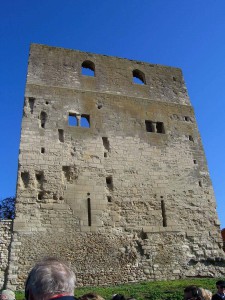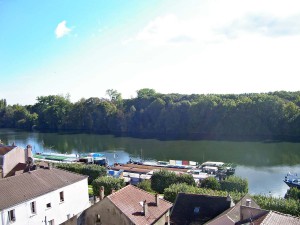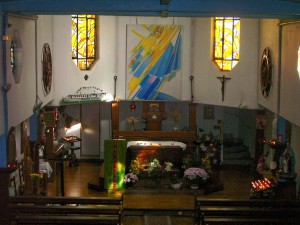FROM PARIS TO NORMANDY ON THE SEINE – TRAVELING ON THE SEINE
FROM PARIS TO NORMANDY ON THE SEINE
This is the third in a series of articles about cruising on the Seine
TRAVELING ON THE SEINE
By Charles N. Stevens
Photos by Dolores Seidman
This morning our ship leaves Paris at dawn, the air so cold that wisps of steam rise from the Seine. Barges line the banks of the river for miles, people using them for their houses. Pots for shrubs, flowers and even small trees decorate their decks in an attempt at landscaping, making their places look like home.
After passing through our first lock we come to a cluster of tall steel and glass buildings, the modern business section of Paris. The contrast of these skyscrapers to the old part of Paris is quite remarkable. We then pass ultra modern apartments close to the banks but with room for a narrow green area and paths close to the river where people can stroll or jog.
Much of the river banks are lined with sloped stone walls to prevent erosion, but I was sorry to see they are fouled with graffiti. We pass the towering stacks of a power plant, steam and smoke billowing out of them, forming a great cloud in the chill air. It must be an old plant because eighty per cent of France’s power is now generated by nuclear facilities. We see a few homeless encampments with the usual messes that surround them.
The river continues to steam. A passing barge slips by through the wisps, looking like a scene out of a movie. Seagulls fly up and down the river, some small and white, others larger like herring gulls. In the ever-changing scenes along the river, we come upon stately stone houses with yards and lawns that slope down to the water’s edge. The ugly walls end as we continue down the Seine, trees now beginning to soften the banks. Several skulls, long thin racing boats, appear on the river, the rhythmic motion of their rowers fascinating to watch.
The farther we get away from Paris, the more scenic the Seine is. We glide by grassy parks with weeping willows that drape to the water. People stroll, jog and ride bicycles along landscaped pathways. Perhaps all this exercise helps keep them slim. The French are adept at providing open spaces for their people. A few fishermen try their luck along the shore.
The Seine becomes even more natural with more trees along its edge, some of them touched with autumn gold. Mallard ducks cruise along the shore and white swans grace the water. Dark cormorants fly low over the water or perch on snags to dry their wings.
Near noon we approach the city of Conflans-Sainte Honorine where more barges appear along the shore, a whole living village of them. At one time the barges were passed on from one generation to another, just like a house. The town gets its name because it is at the confluence of the Seine and Oise Rivers. 35,000 people call Conflans home.
In the afternoon we tour the town, first walking along its linden tree-shaded main street. Nearby, a group of men are taking down an outdoor market and hosing off the walks, the foul smell of fish still in the air. We pass a tobacco shop with its characteristic red sign out front, a symbol that vaguely resembles a carrot since a piece of carrot was often placed in a pipe to keep it moist.
We climb steep streets and stone stairways to reach what is left of a square fort or keep, the Montjoie Tower built soon after the year 1000. The buff-colored stone tower is only ruins now, appreciated by the local pigeons for all its rocky nooks and crannies. At one time it served as a lookout for Viking raiders that traveled up the Seine. I can imagine their boats, their large sails billowing, gliding slowly through the water. From this lofty point we have a great view of the tile-roofed city below, the river and the village of barges.
We move on to the 12th century St. Maclou church, still standing, but now a weathered gothic relic. Just past the church stands the ornate Priory, later a chateau and now a maritime museum. We appreciate its splendid architecture from the outside, but don’t go inside. Nearby is the old dove cote. Only the rich were allowed to have them, but I have no idea why. We end up at Priory Park which is also at the top of the bluff with a fine view of the river. Far in the distance we can see the glass and steel towers of Paris’s business district, an indication of how close we still are to Paris.
Dolores and I, now away from our group and enjoying being on our own, relax on one of the park benches. Children play and squeal on the universal playground equipment—swings, slides and bars to climb on. We rest in the shade of elms and chestnut trees, watching the children having a good time.
On our way back to the ship we walk down a narrow brick road with only a tiny space to walk on either side. A few cars whiz by close to us. Houses on either side are joined, forming a kind of wall with windows and doors. Many houses are adorned with flower boxes, hanging baskets and pots of colorful red chilies. When nearing the river again we pass the inevitable outdoor restaurant with its small tables and chairs. Young men and women sip little coffees or glasses of beer, talk and enjoy each other. And it is an ingrained French tradition to be seen.
Next is a most unusual sight, a barge that has been converted into a church, the Bateau-Chapelle. A pale blue cross marks its outside as well as its stained glass windows. Otherwise it looks like any other barge. The interior is amazing, a complete chapel with wooden pews, an altar, beautiful stained glass windows and the flickering of votive candles. I had no idea there was so much space in a barge.
Back in our room on the ship I watch the sun playing on the water, casting crazy light ripples on the walls and ceiling.

The Montjoie Tower has stood in Conflans for a thousand years watching over the Seine.

From the bluff we look down on the barges where people live on the river.

The amazing Bateau-Chapelle is a barge converted into a church.




It sounds like a wonderful trip! I’ll have to do this one day.